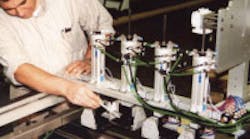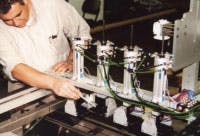Shelf life is the key to success for groceries — particularly for ready-to-eat prepared foods. Obviously, the packaging of these products plays a major role in their shelf life. Orics Industries Inc., Farmingdale, N.Y., a company that engineers automatic packaging systems, supports extended shelf life for prepared foods with its modified-atmosphere packaging (MAP) technology.
Orics’ equipment evacuates the ambient air from the head space above the product, replaces it with a mixture of gases (custom-selected to maximize product life), and then seals the package. Given the wide variety of possible packaging forms and shapes to deal with, all Orics machines are custom-engineered to meet client specifications.
Mapping the process
A typical packaging process — for lasagna trays, in this instance — implements MAP in a system that incorporates PLC-controlled electropneumatic and mechanical actuation to meet the high production rates necessary for survival in the food industry. A servo-driven conveyor delivers rectangular trays filled with lasagna to the packaging equipment (installed perpendicular to the conveyor). Series DSL pneumatic rotary/linear actuators from Festo Corp., Hauppauge, N.Y., are fitted with rod-end grippers that pick up the lead trays, rotate them to the proper orientation for processing in the MAP machine, transfer them to the machine, and release them onto a tray carrier. These dual-function actuators provide both the rotary and the linear motion needed from a single, compact component.
Next, another servo-driven conveyor transports the tray carrier to a station beneath the vacuum chamber assembly. Fiber-optic sensors monitor the presence of trays, signaling the controller if any are missing. The vacuum chamber evacuates the packages’ head space so the appropriate gas mixture can replace the air. Then a film cover is placed over each tray, heat sealed to the tray to capture the gas, and die-cut to trim.
Conventional air cylinders position the floating assembly that holds the heat seal heads and the trimming knives in the servo-driven vacuum/sealing process. A floating spring mechanism holds the whole heating assembly to provide uniform pressure and equal distribution of force around the seal area. Pneumatic valves built to the ISO-10 standard were selected to control these cylinders as well as the other pneumatic functions because Orics machines are shipped to food manufacturers all around the world.
After being heat sealed, finished packages are automatically ejected from the machine with a servo-driven lifting and pushing mechanism and moved to the next station by a Festo Type DGPL rodless pneumatic cylinder. Because no piston rod extends from this type of cylinder, its slide can make its complete stroke within the cylinder’s body length between the end caps. By using a rodless cylinder, the space between the sealing unit and the discharge platform on the Orics machine is reduced by about 50%, keeping the dimensional footprint of the machine at a minimum. (Floor space often is at a premium in food-processing plants.)
The programmable logic controller that operates these packaging machines makes it easy to configure them for a variety of production applications. Commands for all machine functions are input via a digital touch-screen keypad (sealed so that it can be washed down) that interfaces with a Windows-based operating system.
This information was provided by Ori Cohen and Ronit Daniel, of Orics Industries. For more information, call (718) 461-8613, or visit www.orics.com.
#


